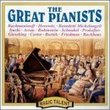| All Artists: Domenico Scarlatti, Edward Parmentier Title: Scarlatti: Fugue & 10 SONATAS Members Wishing: 0 Total Copies: 0 Label: Wild Boar Records Release Date: 1/14/1997 Genre: Classical Styles: Forms & Genres, Sonatas, Historical Periods, Baroque (c.1600-1750) Number of Discs: 1 SwapaCD Credits: 1 UPC: 797551850122 |
Search - Domenico Scarlatti, Edward Parmentier :: Scarlatti: Fugue & 10 SONATAS
 | Domenico Scarlatti, Edward Parmentier Scarlatti: Fugue & 10 SONATAS Genre: Classical
|
Larger Image |
CD DetailsSimilar CDs
|
CD ReviewsAn essential classic, inspiring Bradley P. Lehman | Dayton, VA USA | 03/15/2001 (5 out of 5 stars) "If you haven't already heard Parmentier, you're in for a treat. (And if you do already know his work, you probably already own this CD plus most of his others!)Parmentier's playing is exemplary in showing what a harpsichord can really do. This is a spectacular display of color and rhythmic vitality. There is Flamenco flash here, there is exhilaration, there is humor, and there is deep sorrow (yet with a hold-the-head-up noble poise) in the K87. Like Leonhardt, Parmentier reveals the immediacy of this intense composer. It's infectious, no matter how many times one has listened to this disc. I think I've had my copy for at least thirteen years, and it continues to be a source of inspiration.The harpsichords are also outstanding. There are two here, both by David Sutherland of Ann Arbor MI. Sutherland specializes in building Italian-styled reproductions (such as these), and more recently experimenting with new designs in the spirit of Italian harpsichords. He is completely inside the aesthetics of the sound and the touch, and it shows. These responsive instruments offer the player a remarkable range of expression, even within only one or two registers. (I've played many of his instruments myself...they react like sentient beings, actively suggesting beautiful ways to play the music. That's the mark of a great instrument.) Contrast and color come from sensitive touch moment to moment, not from changes of register. Parmentier takes full advantage of this expressive range: his touch allows the music to breathe, speak, sing, and dance...the compositions come across as living things. They leap, they stalk, they jounce, they growl, they tease, they purr, they swat at bugs. When they move quickly, it's never just a headlong sprint (which one unfortunately hears from too many other harpsichordists in this repertoire). As Parmentier shows, rhythmic vitality is about far more important things than mere ground speed: flexibility, grace, efficiency, intensity, focus, and a lively articulation of every note. Why don't many other people play music in this manner, as if it were alive?This was one of the first CD's in the Wildboar catalogue, released in (I believe) 1985. There were a few LP's before that. Wildboar releases of harpsichord music and chamber music are self-recommending: wonderfully high quality of performances, and the sound is clear and natural...truly audiophile recordings. This CD opened the Wildboar/Parmentier floodgates. If you've heard one of them, you have to get them all." No matter how much Scarlatti you have heard, treat yourself Craig Matteson | Ann Arbor, MI | 12/07/2005 (5 out of 5 stars) "The keyboard sonatas of Domenico Scarlatti have always been popular with audiences. Since there are more than five hundred of these works, it is easily possible to have dozens of recordings by various artists with a substantially different program on each. Yes, there are some standards and favorites, but I do think many harpsichordists and pianists go out of their way to find sonatas they can make their own. While pianists such as Vladimir Horowitz emphasized the brilliance and virtuosity of Scarlatti (and remember that Scarlatti traded on being one of the great virtuosos of his day), others find a brilliance with different kinds of color.
Parmentier has plenty of virtuosity in his playing, but all designed to allow all the richness of the harpsichord to reach out to us in this music. He is never a pianist who happens to be playing a harpsichord. You can listen to any number of harpsichord recordings and not find as much poetry and musicality appropriate to the music as you hear on this disk. We get to hear one of Scarlatti's fugues and ten of the sonatas. Parmentier pairs them in five keys. Two in e minor, two in D (one minor, one Major), two in D Major, two in b minor, two in A major. All delightful, all a treat from a gifted scholar and musician. Thanks to Ed Parmentier for helping us know Scarlatti a little better." |

 Track Listings (11) - Disc #1
Track Listings (11) - Disc #1
